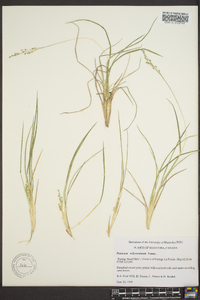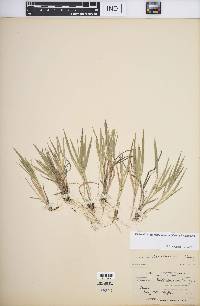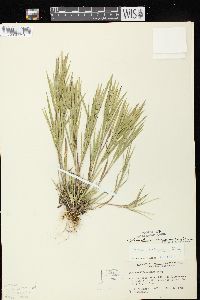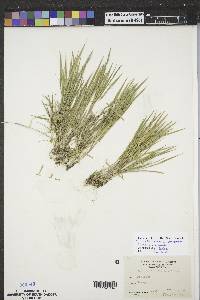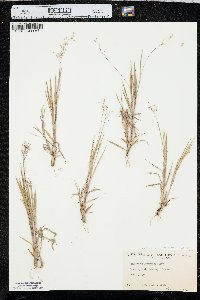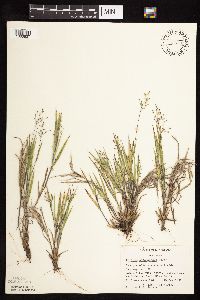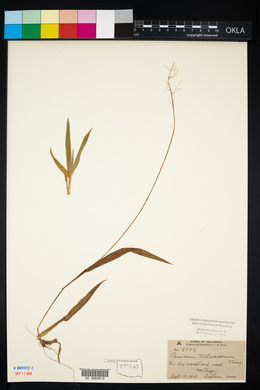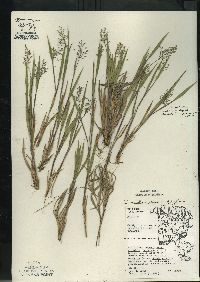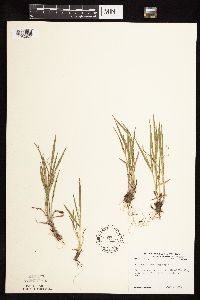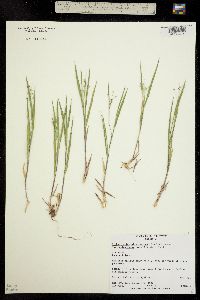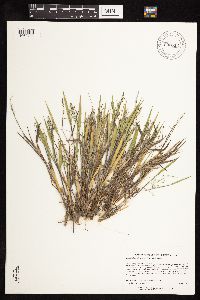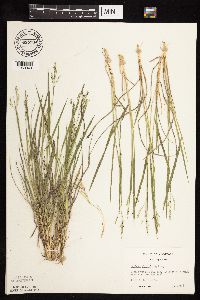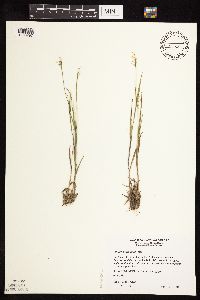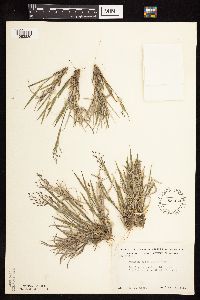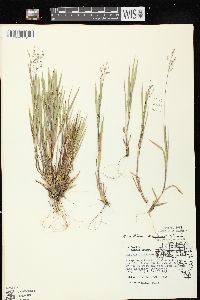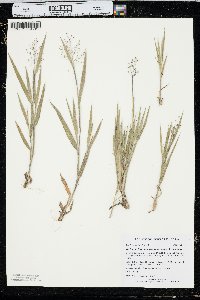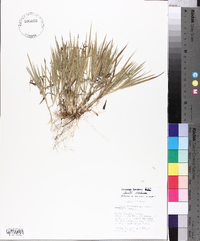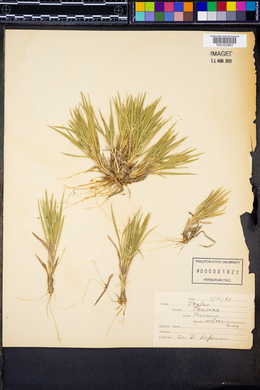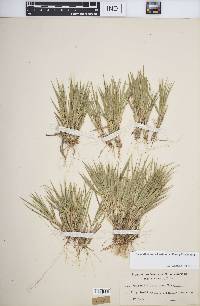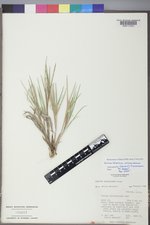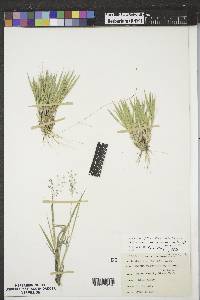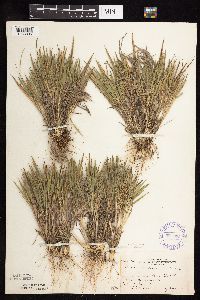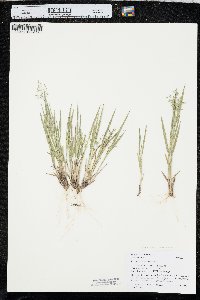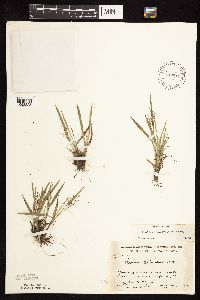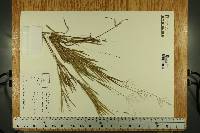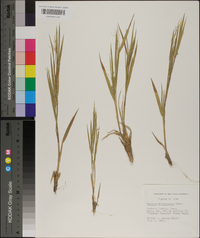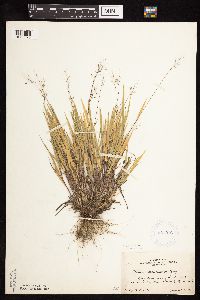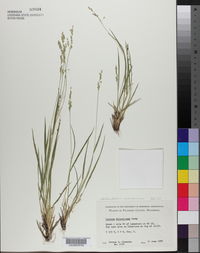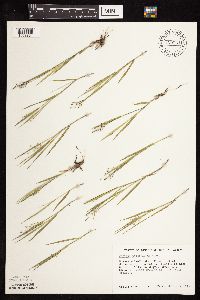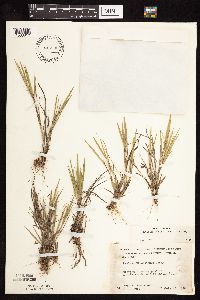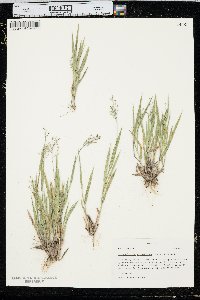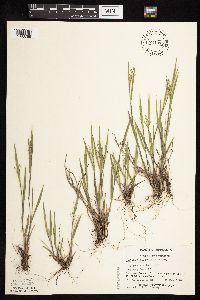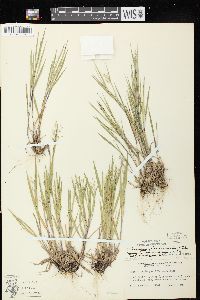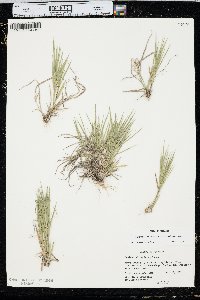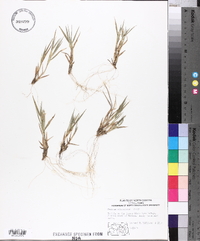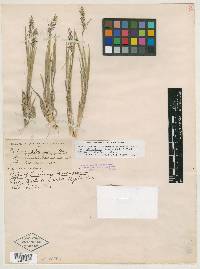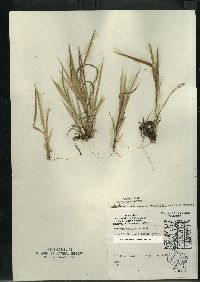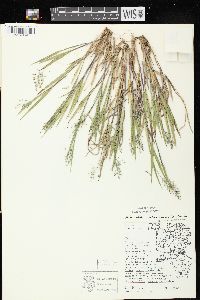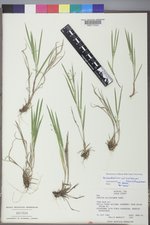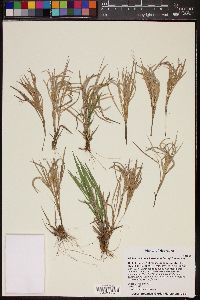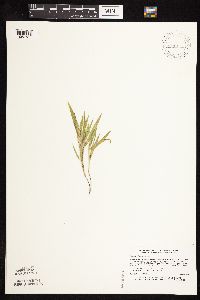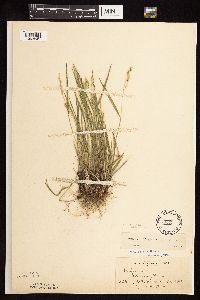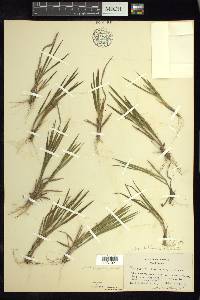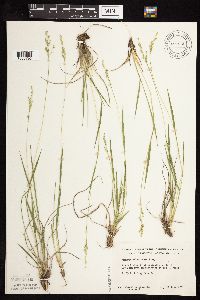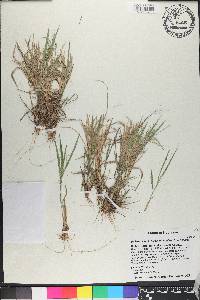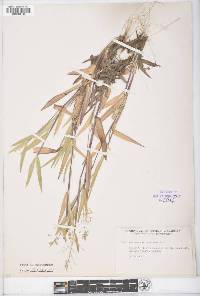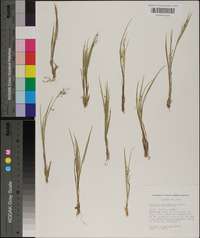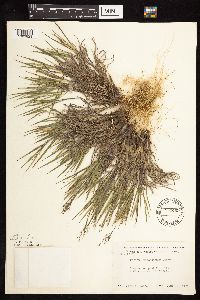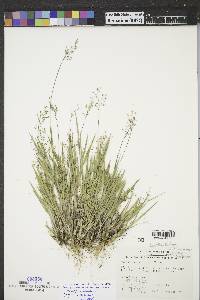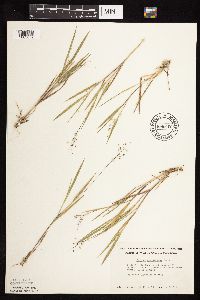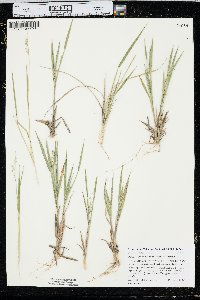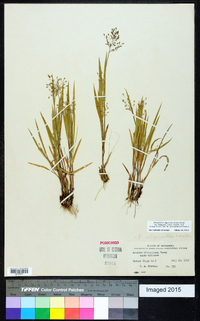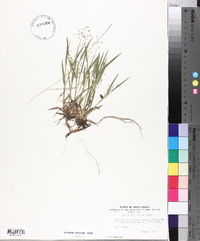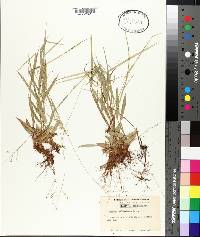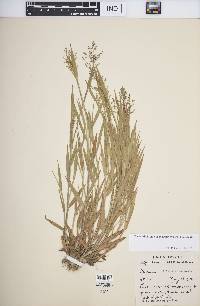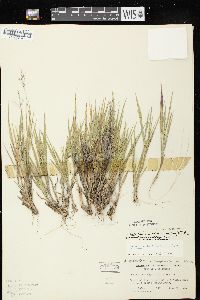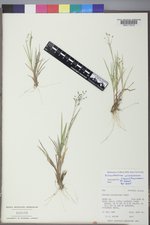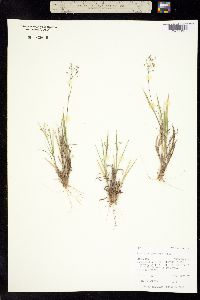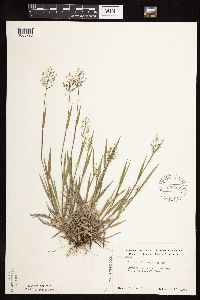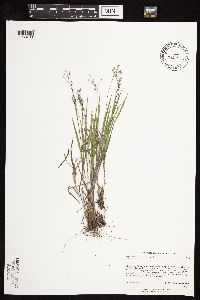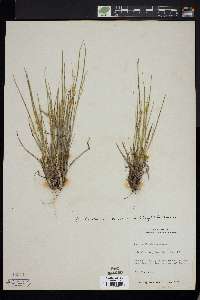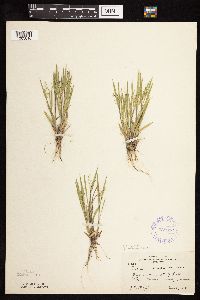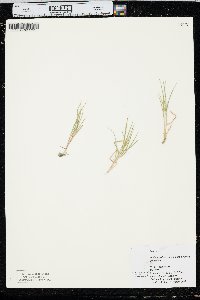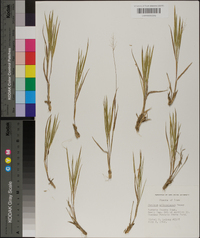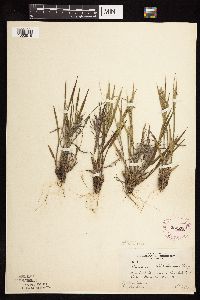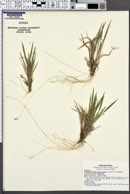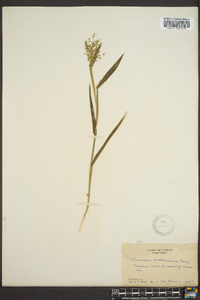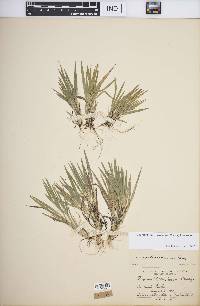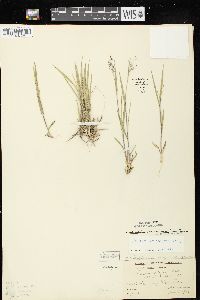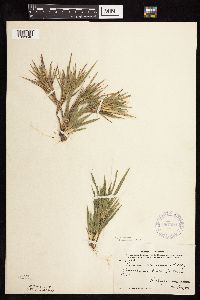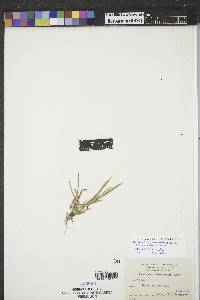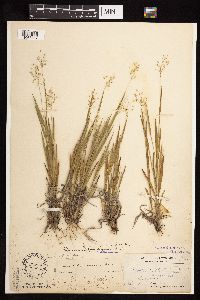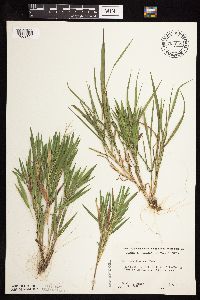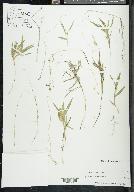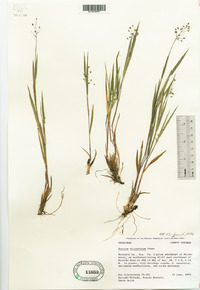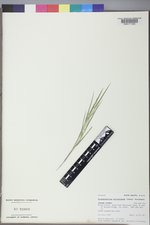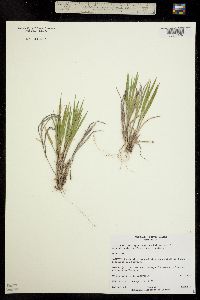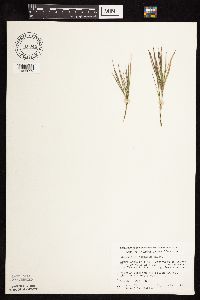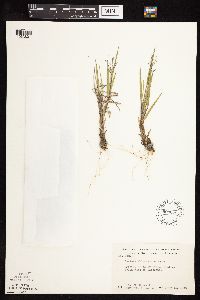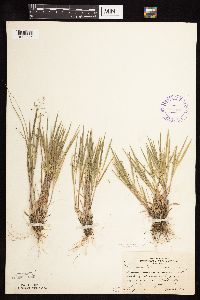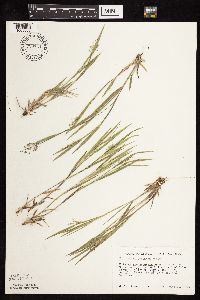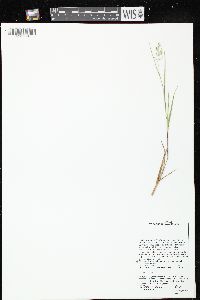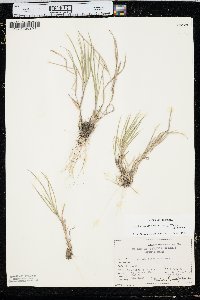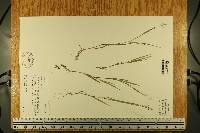
|
|
|
|
Family: Poaceae
Fall Witch Grass, more...fall rosette grass, Wilcox's Panicgrass
[Dichanthelium oligosanthes var. wilcoxianum (Vasey) F.W.Gould & C.A.Clark, moreMilium wilcoxianum (Vasey) Lunell, Panicum wilcoxianum Vasey, Panicum wilcoxianum var. breitungii B.Boivin] |
Plants cespitose. Basal rosettes poorly differentiated; sheaths glabrous; blades 2-4 cm, narrow, similar to those of the lower cauline leaves, ascending to spreading. Culms 15-35 cm, stiffly erect, all but the upper 2-4 internodes very short; nodes glabrous or with weak, reflexed hairs; internodes purplish-gray, sparsely pubescent; fall phase developing early, forming erect branches from the lower or midculm nodes, each branch terminating in a partially included panicle of 8-16 spikelets, no sterile shoots formed. Cauline leaves usually 3; sheaths hirsute, hairs papillose-based; ligules 0.5-1 mm; blades 4-8 cm long, 2-5 mm wide, all alike, stiffly erect, green to grayish-green, flat, not plicate, sparsely pilose. Primary panicles 3-5 cm long, 2-4 cm wide, ovoid, open, shortly exserted, with 12-32 spikelets; branches short, stiff, spreading; pedicels mostly 4-8 mm, spreading. Spikelets 2.4-3.2 mm long, 0.7-1.2 mm wide, ellipsoid to obovoid, often reddish throughout, short-pubescent. Lower glumes 0.7-1.2 mm, triangular; upper glumes and lower lemmas about equaling the upper florets; upper florets 1.9-2.5 mm, ellipsoid, pointed. 2n = 18. Dichanthelium wilcoxianum grows in dry prairies, especially in sandy or gravelly openings. It is restricted to the Flora region. The primary panicles, which are produced from mid-May to early June, are partially open-pollinated; the secondary panicles, which are produced in June, and occasionally also in September, are cleistogamous. Some specimens of Dichanthelium oligosanthes subsp. scribnerianum from the southern Great Plains that have prematurely elongating upper internodes resemble D. wilcoxianum, but they have greenish spikelets that are 1.7-2.4 mm wide, an orange spot at the base of the glumes, and larger basal rosettes. Perennial herb, tufted 15 - 35 cm tall Inflorescence: a terminal, branched arrangement of spikelets (panicle). Primary panicles atop the culms, open, 3 - 5 cm long, 2 - 4 cm wide, egg-shaped, shortly exserted, with twelve to thirty-two spikelets. Secondary panicles (when present) atop the branches. Fruit: a caryopsis, indehiscent, enclosed within the persistent lemma and palea. Culm: stiffly upright, 15 - 35 cm long, round in cross-section, hollow, sparsely hairy. Lower internodes much shorter than the elongated upper two to four internodes. Nodes sometimes having weak, reflexed hairs. Fall phase developing relatively early, branching from the lower and mid-culm nodes, producing secondary panicles but no sterile shoots. Spikelets: often reddish, 2.5 - 3 mm long, 0.5 - 1 mm wide, narrowly ellipsoid or reverse egg-shaped, shortly hairy. Basal leaves: in a rosette. Blades ascending to spreading, 2 - 4 cm long, narrow, similar in shape to lower stem leaves. Stem leaves: usually three, alternate, two-ranked. Sheaths hairy with bumpy-based hairs. Ligules 0.5 - 1 mm long, composed of hairs. Blades stiff, upright, 4 - 8 cm long, 2 - 5 mm wide, flat, parallel-veined, sparsely soft-hairy. Glumes:: Lower glumes 0.5 - 1 mm long, triangular. Upper glumes about equal to upper florets, rounded to pointed at the apex. Lemmas:: Lower lemmas similar to upper glumes, about equal to upper florets. Upper lemmas longitudinally lined, shiny, with rolled-up margins above. Paleas:: Lower paleas shorter than lower lemmas, thin. Upper paleas longitudinally lined. Florets:: Upper florets bisexual, stalkless, 2 - 2.5 mm long, ellipsoid with a pointed apex, plump. Anthers three. Stigmas red. Similar species: No information at this time. Flowering: June to September Habitat and ecology: Rare on gravelly hill prairies in the northwestern sector of the Chicago Region. It may also be found on open wooded dunes and sandy knolls in northwestern Indiana. Occurence in the Chicago region: native Etymology: Dichanthelium comes from the Greek words di, meaning twice, and anth, meaning flowering, referring to plants that may have two flowering periods. Wilcoxianum is named after Timothy Erastus Wilcox ((1840-1932), the person who discovered this species. Author: The Morton Arboretum Culms densely clustered, erect, 1-3 dm, papillose-hirsute with ascending hairs to sparsely villous; sheaths loose, usually longer than the internodes, papillose-hirsute with hairs usually 2-5 mm; ligule a band of short hairs 0.4-1.6 mm; blades erect, 4-8 cm נ2-6 mm, scarcely wider than the sheaths, involute distally, papillose-hirsute on both sides, varying to nearly glabrous above; primary panicle tardily exsert, ovoid, 2-4 cm, the flexuous axis and branches glabrate except in the axils; spikelets softly villosulous, ellipsoid-obovoid, 2.4-2.9 mm; first glume a third to nearly half as long, broadly ovate, obtuse to acute; second glume slightly shorter than the fr and sterile lemma; autumnal phase branching early, before maturity of the primary panicle, from all nodes, forming dense masses 1-2 dm, the erect blades scarcely reduced, much surpassing the small panicles; 2n=18. Dry prairies; Ill. and n. Ind. to Man., Kans., and N.M. (P. deamii; Dichanthelium oligosanthes var. w.; Dichanthelium w.) Gleason, Henry A. & Cronquist, Arthur J. 1991. Manual of vascular plants of northeastern United States and adjacent Canada. lxxv + 910 pp. ©The New York Botanical Garden. All rights reserved. Used by permission. From Flora of Indiana (1940) by Charles C. Deam Indiana Coefficient of Conservatism: C = 10 Wetland Indicator Status: N/A |

